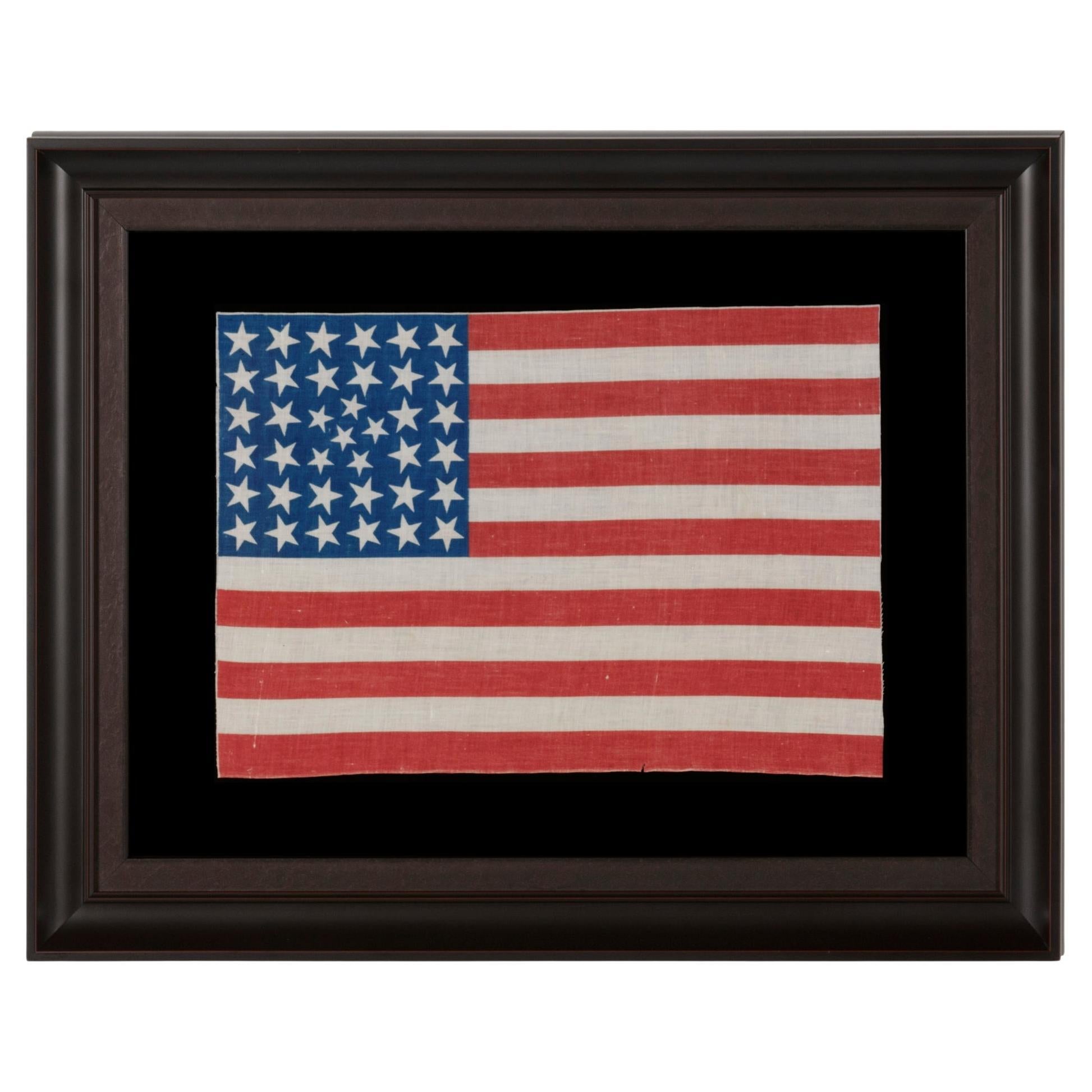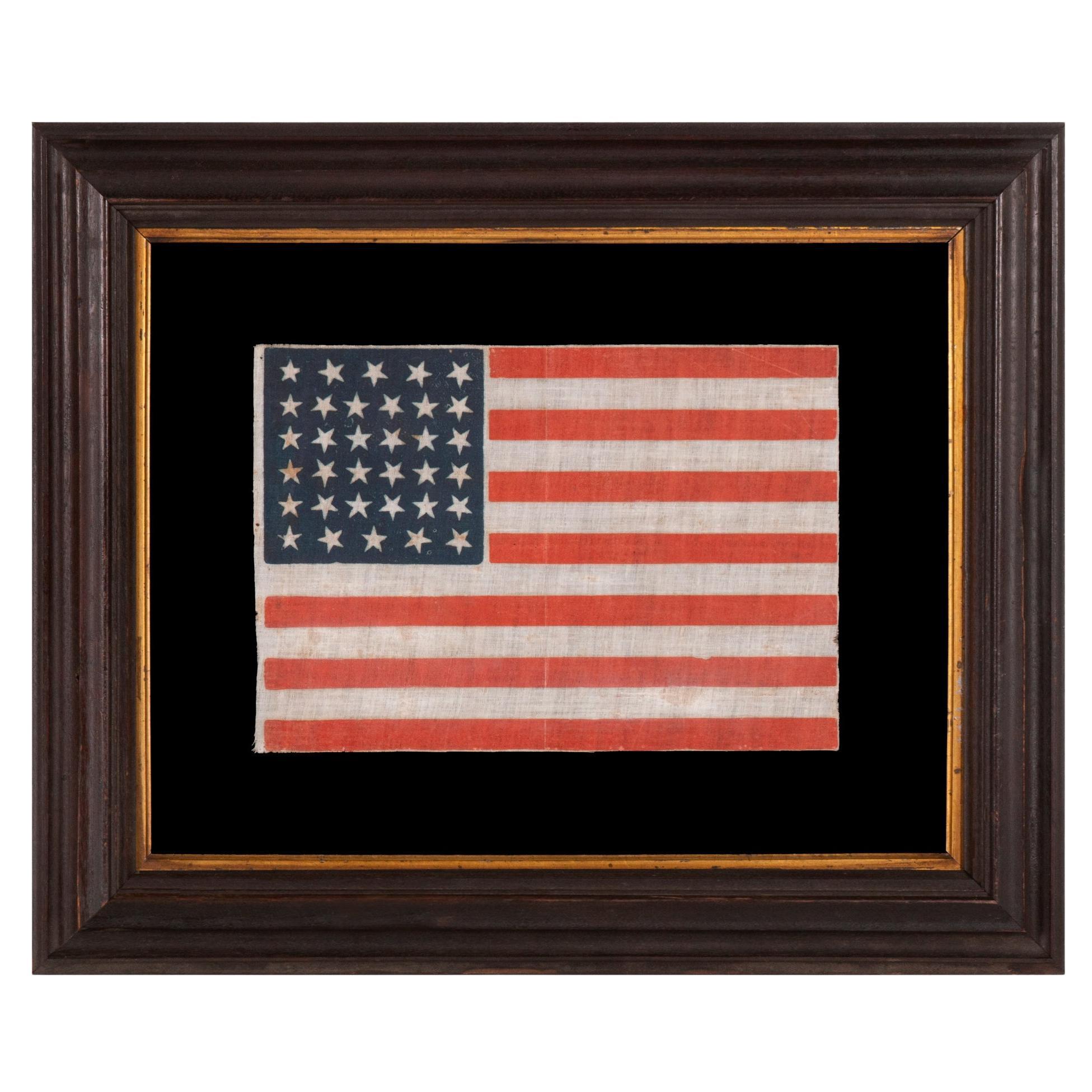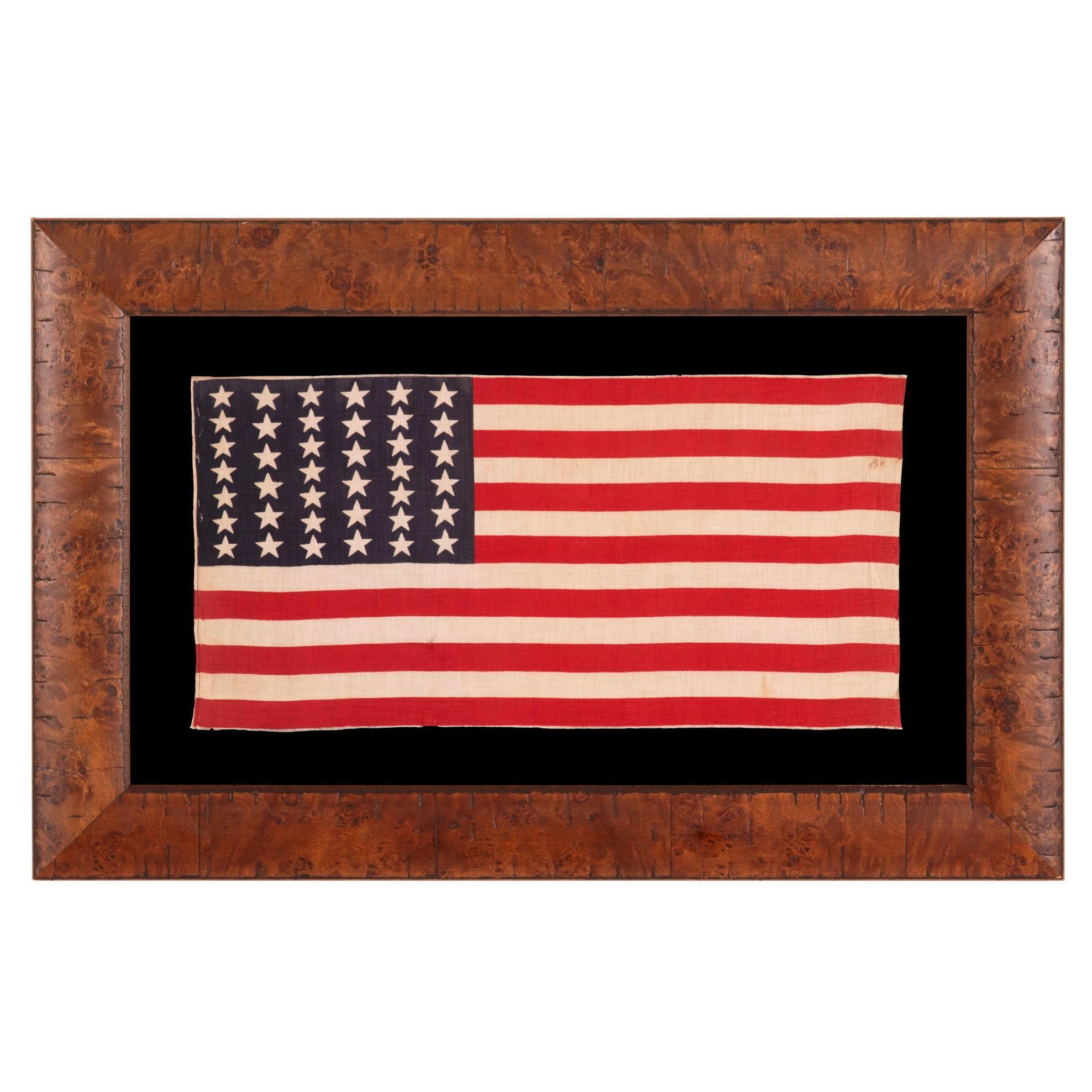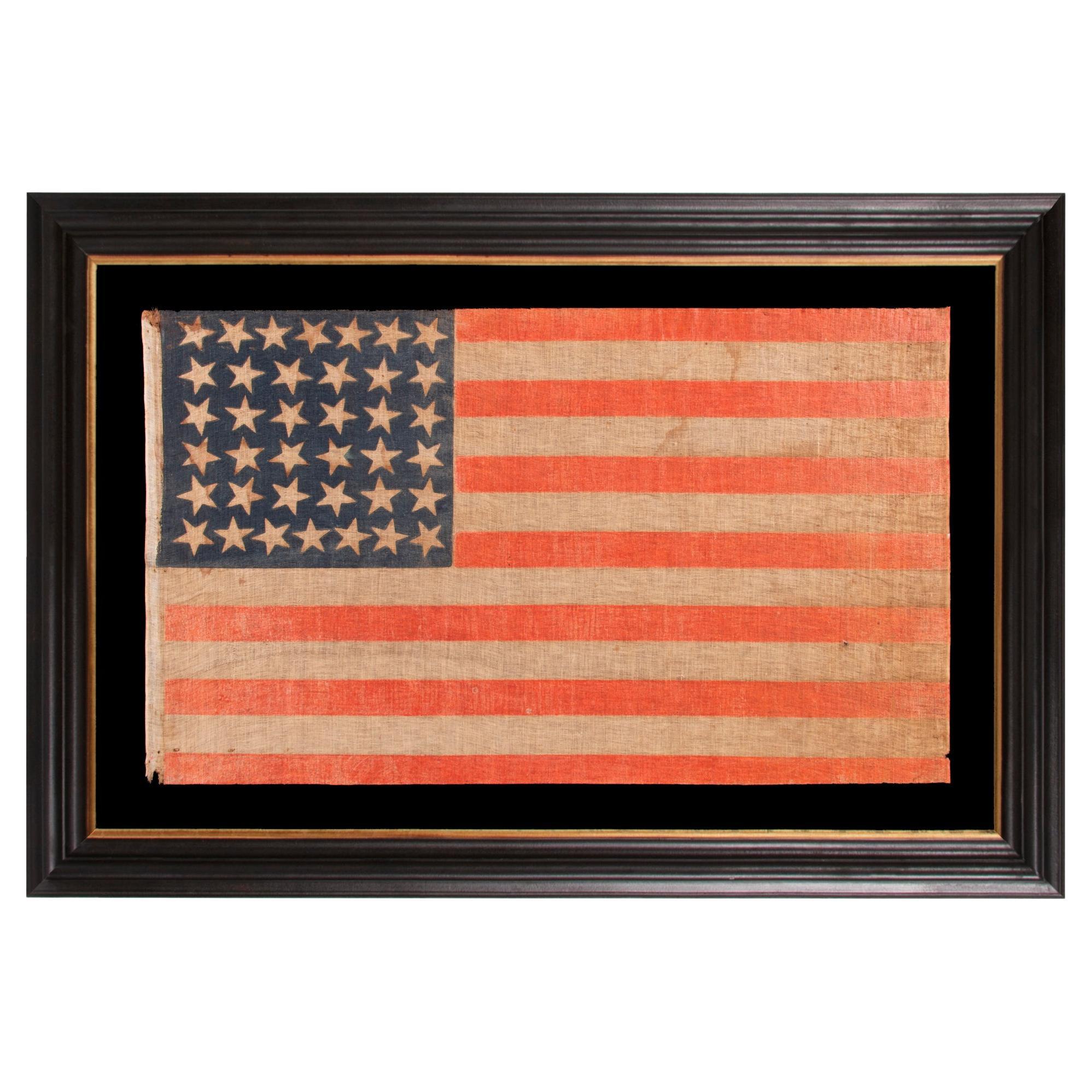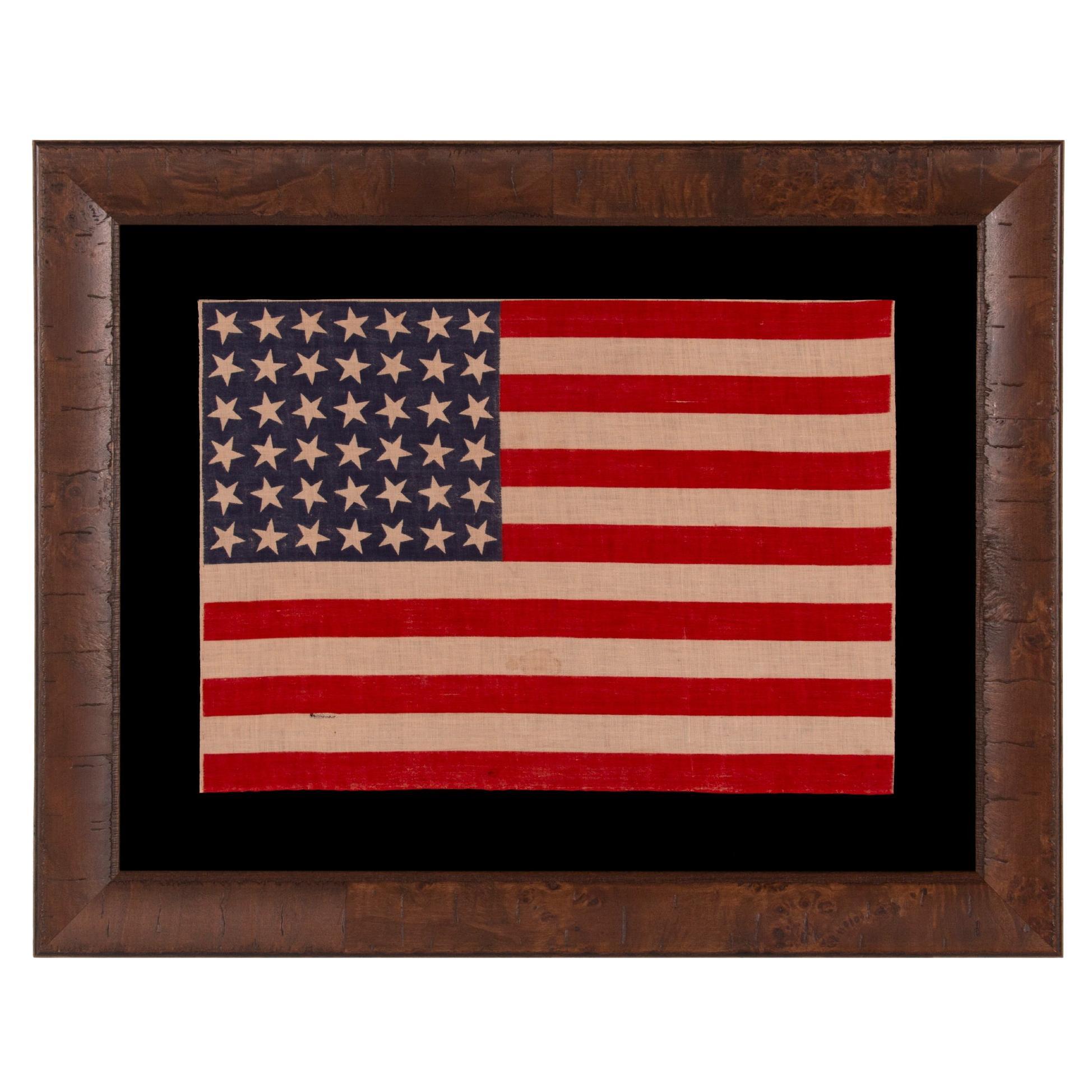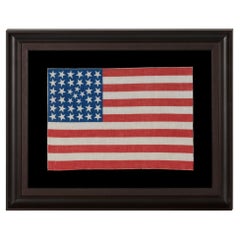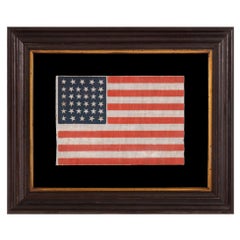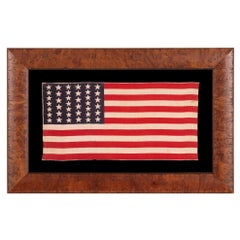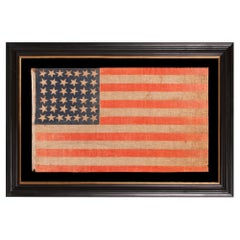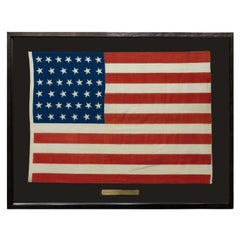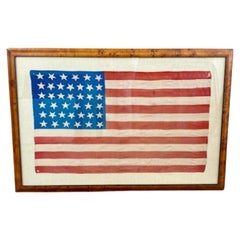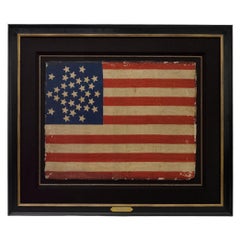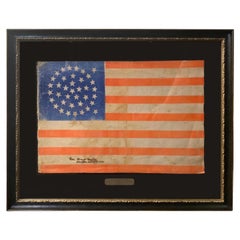Items Similar to 13 Star Antique American Parade Flag, ca 1876-1899
Want more images or videos?
Request additional images or videos from the seller
1 of 6
13 Star Antique American Parade Flag, ca 1876-1899
Price Upon Request
Price Upon Request
Price Upon Request
Price Upon Request
Price Upon Request
Price Upon Request
Price Upon Request
Price Upon Request
Price Upon Request
Price Upon Request
About the Item
13 STAR ANTIQUE AMERICAN PARADE FLAG, WITH A 3-2-3-2-3 CONFIGURATION OF STARS, AN EXTREMELY SCARCE AND UNUSUALLY LARGE VARIETY, MADE circa 1876-1899
13 star American national parade flag, printed on cotton, made sometime during the last quarter of the 19th century. This is a very rare size for a parade flag in the 13 star count. The most common variety measures just 3 inches on the fly, and practically none reach over 10 inches. Before acquiring a small group in this large and unusual form, close to 20 years ago, neither I, nor anyone else I knew in the world of flag collecting, had seen anything similar.* The group I acquired was discovered in Canada, and, given what I knew about 13 star parade flags, it was reasonable to assume that they were likely either produced there for the American market, or else made in the States for some Canadian-based event with U.S. involvement. Whatever the case may be, others in the same style have since been found north of the border, and Canadian manufacture would explain the scarcity.
The stars are quite large in scale. Each is canted at a slight angle, such that one point is directed in the 1:00 position. These are arranged in staggered lineal rows in counts of 3-2-3-2-3, which is the most common configuration found in 13 star flags of the late 19th century, with pieced-and-sewn construction, but is highly unusual among printed parade flags.
In most cases the 3-2-3-2-3 design can also be viewed as a diamond of stars, with a star in each corner and a star in the very center. It is of interest to note that the 3-2-3-2-3 pattern can also be interpreted as a combination of the crosses of St. Andrew and St. George, which some feel could have been the design of the very first American flag and may identify a link between this star configuration and the British Union Jack. The pattern is often attributed--albeit erroneously in my opinion--to New Jersey Senator Francis Hopkinson, a member of the Second Continental Congress and signer of the Declaration of Independence, who is credited with having played the most significant role in the original design of the American national flag. Hopkinson's original drawings for the design of the flag have not survived and his other depictions of 13 star arrangements for other devices are inconsistent.
On this particular example, note the unusual coloration of the hoist area, adjacent to the canton, which is red instead of the typical white. This adds a distinctly unusual feature to the flag's visual presentation and is a nice compliment to the field of large, canted stars.
The presence of so much white fabric beyond the last red stripe is also not typical of parade flag production. This was done so that there would be room for error when trimming between one flag and the next. Parade flags were printed on a bolt of fabric, like other printed textiles, and were clipped from the bolt at the point of sale, or perhaps afterwards, if the buyer bought multiple flags. When printed horizontally across the bolt, or when small flags were printed next to one-another vertically in multiples, Most parade flags had only a tiny amount of space between them, and some print runs allowed no space at all. It is extremely unusual to encounter flag printed perpendicular to the bolt, with selvage (finished, woven edges) along the hoist and fly, that have enough white fabric beneath and above them to actually look as if the maker intended American flags to have 14 stripes.**
13 star flags have been flown throughout our nation’s history for a variety of purposes. They were hoisted at patriotic events, including Lafayette’s visit in 1824-25, the celebration of the nation’s centennial in 1876, and the sesquicentennial in 1926. They were displayed during the Civil War, to reference past struggles for American liberty, and were used by 19th century politicians in political campaigning for the same reason. The U.S. Navy used the 13 star count on small boats until 1916, because it was easier to discern fewer stars at a distance on a small flag. Commercial flag-makers mirrored this practice and some private ships flew 13 star flags during the same period as the Navy. The use of yachting ensigns with a wreath of 13 stars surrounding a fouled anchor, which allowed pleasure boats to bypass customs between 1848 and 1980, persists today without an official purpose.
Mounting: The flag was mounted and framed within our own conservation department, which is led by expert staff. We take great care in the mounting and preservation of flags and have framed thousands of examples.
The background fabric is 100% cotton twill, black in color, that has been washed and treated for colorfastness. The extraordinary, 3-part molding is constructed of wood, but has a finish that presents like antique iron. Spacers keep the textile away from the glass, which is U.V. protective. Feel free to contact us for more details.
Condition: There is minor to modest soiling in the white fabric, accompanied by a semi-lineal streak across the white are below the last red stripe. Many of my clients prefer early flags to show their age and history of use.
* With the exception of a tiny handful of extremely rare examples with political advertising, made during the mid 19th century.
** Note that some parade flags are printed parallel to the bolt, and on occasion have lots of fabric on one or both sides. This is also unusual and is typically seen on very early examples, pre-dating the American Civil War (1861-65).
Frame Size (H x L): Approx. 24.25" x 33.25"
Flag Size (H x L): 15.25" x 24"
- Dimensions:Height: 24.25 in (61.6 cm)Width: 33.25 in (84.46 cm)Depth: 2 in (5.08 cm)
- Materials and Techniques:
- Place of Origin:
- Period:
- Date of Manufacture:1876-1899
- Condition:See Item Description.
- Seller Location:York County, PA
- Reference Number:Seller: 13j-17161stDibs: LU849745343372
About the Seller
5.0
Recognized Seller
These prestigious sellers are industry leaders and represent the highest echelon for item quality and design.
Established in 1991
1stDibs seller since 2008
70 sales on 1stDibs
Typical response time: 16 hours
- ShippingRetrieving quote...Shipping from: York County, PA
- Return Policy
Authenticity Guarantee
In the unlikely event there’s an issue with an item’s authenticity, contact us within 1 year for a full refund. DetailsMoney-Back Guarantee
If your item is not as described, is damaged in transit, or does not arrive, contact us within 7 days for a full refund. Details24-Hour Cancellation
You have a 24-hour grace period in which to reconsider your purchase, with no questions asked.Vetted Professional Sellers
Our world-class sellers must adhere to strict standards for service and quality, maintaining the integrity of our listings.Price-Match Guarantee
If you find that a seller listed the same item for a lower price elsewhere, we’ll match it.Trusted Global Delivery
Our best-in-class carrier network provides specialized shipping options worldwide, including custom delivery.More From This Seller
View All38 Star Antique American Parade Flag, Colorado Statehood, ca 1876-1889
Located in York County, PA
38 STARS IN AN EXTREMELY UNUSUAL CONFIGURATION THAT BEARS A CLUSTER OF 6 SMALL STARS WITHIN A LINEAL PATTERN OF LARGER STARS, 1876-1889, COLORADO STATEHOOD
38 star American national parade flag, printed on cotton. This is an extremely rare example of a lineal pattern flag with a wreath or cluster of smaller stars inserted in the center. A very small number of flags in this style are known to have survived, the colors of which are typically saturated and vibrant, like this example, in scarlet red and rich, royal blue.
The particular wreath in the center of the configuration is really more of a pentagon with a single, center star. The reason for the choice of the design and 6 smaller stars seems a curious one on the surface, but its purpose was probably nothing more than to simply augment a 36 star print block to one with 38 stars. One may observe how 4 stars, that would have comprised the center of a 6 x 6 pattern, could have simply been removed and 6 smaller stars inserted in their place, in an artful fashion.
At least two other similar 38-star patterns are known that incorporate 4 small stars intermingled between rows of what most certainly were two very similar 34-star flag print blocks originally. It was easier to modify these blocks rather than create brand new ones. In these particular instances, the results are rare, quirky configurations that are highly prized by collectors.
Colorado became the 38th state on August 1st, 1876. This was the year of our nation’s 100-year anniversary of independence. Per the Third Flag Act of 1818, stars were not officially added until the 4th of July following a state's addition. For this reason, 37 was the official star count for the American flag in 1876. Flag-making was a competitive venture, however, and few flag-makers would have been continuing to produce 37 star flags when their competitors were making 38’s. It is for this reason that 38 and 13 stars (to represent the original 13 colonies) are more often seen at the Centennial International Exposition, the six-month long World’s Fair held in Philadelphia in honor of the event. Some flag-makers would have been adding a star for the 38th state even before it entered the Union, in the early part of 1876 or even prior. In fact, many makers of parade flags were actually producing 39 star flags, in hopeful anticipation of the addition of two more Western Territories instead of one. But the 39th state would not join the Union for another 13 years, when the Dakota Territory entered as two states on the same day. The 38 star flag became official on July 4th, 1877 and was generally used until the addition of the Dakotas in 1889.
Provenance: Jeff R. Bridgman Antiques to the late collector Jim Ring...
Category
Antique Late 19th Century American Political and Patriotic Memorabilia
Materials
Cotton
Price Upon Request
34 Star Antique American Parade Flag, Kansas Statehood, ca 1861-1863
Located in York County, PA
34 STARS, WITH SCATTERED POSITIONING, ON AN ANTIQUE AMERICAN PARADE FLAG MADE DURING THE OPENING TWO YEARS OF THE CIVIL WAR, 1861-63, KANSAS STATEHOOD
34 star American national flag...
Category
Antique 1860s American Political and Patriotic Memorabilia
Materials
Cotton
Price Upon Request
39 Star Antique American Parade Flag with Stars in Two Sizes, Ca 1876
Located in York County, PA
39 STARS IN TWO SIZES, ALTERNATING FROM ONE COLUMN TO THE NEXT, ON AN ANTIQUE AMERICAN PARADE FLAG WITH AN UNUSUALLY ELONGATED PROFILE, DATING TO THE 1876 CENTENNIAL, NEVER AN OFFICI...
Category
Antique 1870s American Political and Patriotic Memorabilia
Materials
Cotton
38 Star Antique American Parade Flag, Colorado Statehood, ca 1876-1889
Located in York County, PA
38 STAR ANTIQUE AMERICAN PARADE FLAG WITH JUSTIFIED ROWS OF 7-6-6-6-6-7 AND SCATTERED STAR ORIENTATION, MADE DURING THE PERIOD WHEN COLORADO WAS THE MOST RECENT STATE TO JOIN THE UNION, 1876-1889
38 star American national parade flag, printed on coarse cotton, possibly with flax content. One of the flag’s most interesting features is the wild sweep of the grain of the fabric, the warp and weft of which are anything but perpendicular.
The stars are arranged in justified rows of 7-6-6-6-6-7. This results in a secondary pattern that I commonly call a “box-in-a-box-in-a-box”, because of the way in which the seemingly haphazard arrangement creates three consecutive squares. Note how the stars point in various directions on their vertical axis, which adds a nice element of folk quality to the overall design.
Most parade flags in this star count have red stripes that lean heavily toward orange, with a vibrant, chromatic luster. This was common across printed flags produced between the 1850's and the 38 star period, phasing out in the last decade of the 19th century. Also note how the wear and patina contribute to an endearing presentation that displays its long-term use gracefully.
Colorado became the 38th state on August 1st, 1876. This was the year of our nation’s 100-year anniversary of independence. Per the Third Flag Act of 1818, stars were not officially added until the 4th of July following a state's addition. For this reason, 37 was the official star count for the American flag in 1876. In the latter 19th century, it became common to add stars before the respective state(s) had even entered the Union. No one cared what was official, not even the military, where the matter of practicality with regard to flags always seems to have outweighed regulations. In the private sector, commercial flag-making was a competitive venture. Few flag-makers continued to produce 37 star flags when their competitors had jumped the star count to 38. It is for this reason that 38 and 13 stars (to represent the original 13 colonies) are more often seen at the Centennial International Exposition, the six-month long World’s Fair, held in Philadelphia, that served as the nucleus of the national celebration.
Some makers of printed parade flags actually began to produce 39 star flags in 1876, in hopeful anticipation of the addition of two more Western Territories instead of one. The 39th state would not join the Union for another 13 years, however, when the Dakota Territory—thought to be coming as a single state—entered as two separate states on November 2nd, 1889. The 38 star flag generally fell out of production at that time, though it technically remained official until July 3rd, 1890.
President Ulysses S. Grant was in office when the first 38 star flags would have appeared. The list of presidents that served during the period when the 38 star flag was official include Rutherford B. Hayes, James Garfield...
Category
Antique Late 19th Century American Political and Patriotic Memorabilia
Materials
Cotton
Price Upon Request
42 Star Parade Flag with Scattered Stars, ca 1889-1890
Located in York County, PA
42 STARS ON AN ANTIQUE AMERICAN FLAG WITH SCATTERED STAR POSITIONING, REFLECTS THE ADDITION OF WASHINGTON STATE, MONTANA, AND THE DAKOTAS, NEVER AN OFFICIAL STAR COUNT, circa 1889-18...
Category
Antique Late 19th Century American Political and Patriotic Memorabilia
Materials
Cotton
42 Stars on a Antique American Parade Flag, Washington Statehood, ca 1889-1890
Located in York County, PA
42 STARS ON AN ANTIQUE AMERICAN FLAG WITH A WAVE CONFIGURATION OF LINEAL COLUMNS, AN UNOFFICIAL STAR COUNT THAT REFLECTS THE ADDITION OF WASHINGTON STATE, MONTANA, AND THE DAKOTAS, c...
Category
Antique Late 19th Century American Political and Patriotic Memorabilia
Materials
Cotton
You May Also Like
39-Star Antique American Flag with 'Whimsical' Star Pattern, 1889
Located in Colorado Springs, CO
This is a 39-star unofficial American flag, handmade and printed on cotton. The flag dates to 1889 and has a unique history, thanks to its rare star-count.
The flag’s canton is prin...
Category
Antique 1880s American Political and Patriotic Memorabilia
Materials
Cotton
19th Century American 39 Star Flag, circa 1889
Located in Nantucket, MA
19th Century American 39 Star Flag, circa 1889, a period printed silk parade flag with a wavy pattern of dancing stars. This was never an official flag of the United States but was m...
Category
Antique 1880s American Federal Political and Patriotic Memorabilia
Materials
Silk
31-Star Printed American Flag, Celebrating California Statehood, Circa 1850
Located in Colorado Springs, CO
This is a rare 31-star medallion printed American flag, celebrating the addition of California to the Union. The flag is printed on silk and has a spectacular “Great Star” canton pat...
Category
Antique 1850s American Political and Patriotic Memorabilia
Materials
Silk
38-Star American Parade Flag, Flown at a Reception for President Grant, 1880
Located in Colorado Springs, CO
This is a beautifully colored 38-star American parade flag, flown at a public reception for Ulysses S. Grant in October of 1880. This printed flag features a rare, triple medallion s...
Category
Antique 1880s American Political and Patriotic Memorabilia
Materials
Cotton
48-Star Printed American Flag, Commemorating Arizona Statehood, 1912-1958
Located in Colorado Springs, CO
This is an original 48-star American parade flag, celebrating Arizona statehood. A wonderful product of our nation's early history, this flag is an authentic antique, with a fly date...
Category
Mid-20th Century American Political and Patriotic Memorabilia
Materials
Fabric
Early 20th C. Monumental American Flag with 48 Stars, c.1940-1950
Located in San Francisco, CA
About
This is an original monumental American flag made with 48 hand sewn stars and stripes. It is in good condition and has brass grommets to hang.
Creator unknown.
Date of m...
Category
Early 20th Century Industrial Political and Patriotic Memorabilia
Materials
Brass
More Ways To Browse
Black Memorabilia
New Jersey 19th Century
U V Diamond
Large Iron Crosses
Liberty Fabric
Declaration Of Independence
Canada Antiques
Antique Union Jack
Iron Ship Anchor
19th Century American Flag
Navy Jack Flag
British Union Jack
13 Star Flag
1876 American Flag
Antique 13 Star Flag
Antique 13 Star American Flag
World War 2 American Flag
War Of 1812
